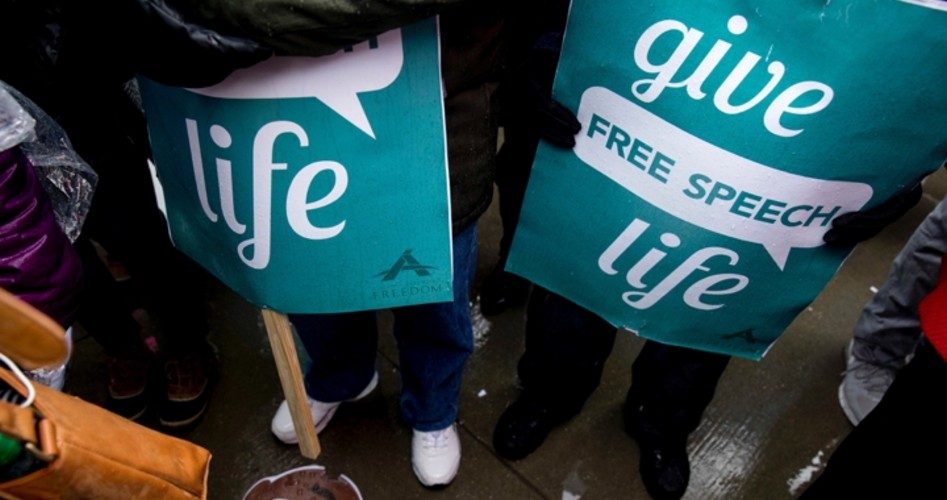
The Supreme Court ruled 5-4 in favor of a group of California crisis-pregnancy centers Tuesday, finding that a state law forcing pregnancy centers to inform clients how to obtain state-funded abortions was a violation of the First Amendment’s guarantee of freedom of speech.
Writing for the majority, Justice Clarence Thomas declared, “California cannot co-opt the … facilities to deliver its message for it,” particularly in light of the fact that the message directly contradicts the facilities’ convictions and objective, namely saving babies from abortion.
The law in question, the Reproductive FACT (Freedom, Accountability, Comprehensive Care, and Transparency) Act, compels pregnancy centers licensed to perform medical services to post a notice — in a specified font size — informing clients that “California has public programs that provide immediate free or low-cost access to comprehensive family planning services …, prenatal care, and abortion for eligible women” and supplying them with the telephone number of their county social services office. In addition, it requires unlicensed facilities to include a 29-word statement to that effect both onsite and in all their advertising.
Under the latter mandate, “California conceded at oral argument, a billboard for an unlicensed facility that says ‘Choose Life’ would have to surround that two-word statement with a 29-word statement from the government, in as many as 13 different languages,” Thomas penned. The requirement, he maintained, “targets speakers, not speech, and imposes an unduly burdensome disclosure requirement that will chill their protected speech.”
The FACT Act was challenged in court almost as soon as Governor Jerry Brown’s (D) signature on it was dry. The National Institute of Family and Life Advocates (NIFLA), an association of crisis-pregnancy centers with about 135 members in California, sought a preliminary injunction of the law but was rebuffed by both a federal judge and the Ninth U.S. Circuit Court of Appeals. NIFLA appealed to the Supreme Court, which agreed in November to hear the case.
In their concurring opinion, Chief Justice John Roberts and Justices Anthony Kennedy, Samuel Alito, and Neil Gorsuch noted that California claimed the FACT Act was part of its legacy of “forward thinking.” “But,” they observed, citing a 1977 decision, “it is not forward thinking to force individuals to ‘be an instrument for fostering public adherence to an ideological point of view [they] fin[d] unacceptable.’” Instead, they counseled studying the original understanding of the First Amendment and the history of tyrants’ suppression of free speech.
NIFLA president Thomas Gessler, naturally, applauded the court’s decision, saying in a statement, “The right of free speech protected in the First Amendment not only includes the right to speak, but also the right to not be compelled by government to speak a message with which one disagrees and which violates one’s conscience. The court correctly found that the California law clearly offends this principle.”
After echoing Gessler’s sentiments, Michael Farris, president and CEO of the Alliance Defending Freedom, which litigated the case, added, “Tolerance and respect for good-faith differences of opinion are essential in a diverse society like ours. They enable us to coexist peacefully with one another. If we want to have freedom for ourselves, we have to extend it to others.”
Of course, not everyone was so thrilled about the court’s finding.
In a statement, California Attorney General Xavier Becerra (D) called the ruling “unfortunate” but vowed to “continue” to fight — presumably in other ways — “to ensure that Californians receive accurate information about their healthcare options.”
Justices Stephen Breyer, Ruth Bader Ginsburg, Sonia Sotomayor, and Elena Kagan also took issue with their colleagues’ decision. Their dissent, authored by Breyer, is not without merit to the extent that it points out the court’s various contradictory rulings on free-speech cases over the years and the occasionally strained ways in which the majority strove to thread that needle. Indeed, the court’s many rulings on such matters, which have often sought to circumvent the plain meaning of the First Amendment, have made it possible for justices of all political persuasions to find ample precedents for any decision they wish to issue.
Even so, the majority’s sentiments, if not their legal contortions, were correct in this case: People should not be compelled by the government to express things that violate their consciences.
Photo: AP Images



